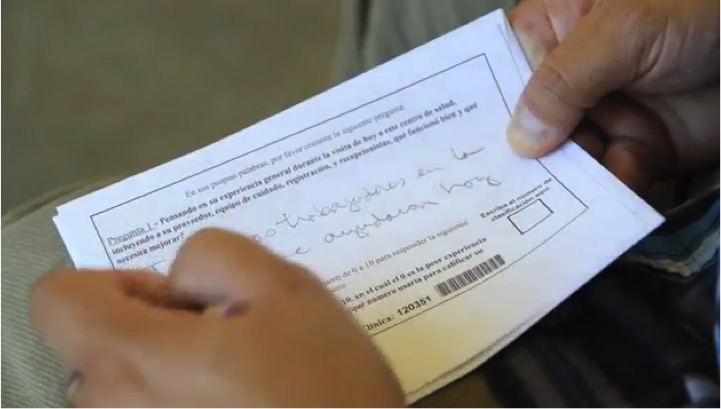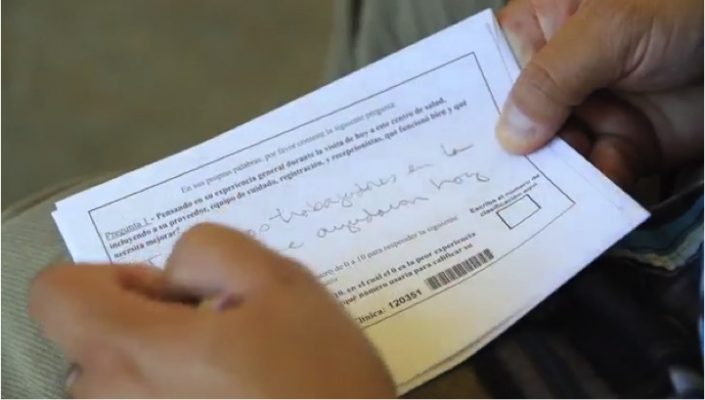Improving the patient experience is a priority for many clinics, but gathering meaningful and useful information about how patients actually feel about their visits can be a major challenge. CCI’s Engaging Patients to Improve Care program helped three health centers implement the Pulse One Minute Survey, which, combined with analytics by Quality Data Management, turns verbatim feedback into actionable insights.
Seeing the Problem
Research has shown that patient experience may be as vital to the success of a healthcare organization as quality of care. In fact patients who report being satisfied with their clinic experience are also more likely to rate their care highly—and they are more likely to follow their care plan. For this reason the Triple Aim includes the imperative for health centers to ensure that patients find their visits efficient, comfortable, pleasant and easy to navigate.
However measuring the patient experience can be a vexing problem. Unlike data on outcomes or lab results, patient experience feedback tends to be either qualitative or amorphous. Clinic leaders can make educated guesses about what to improve, but with budgets in the safety net so tight and staff often stretched by multiple improvement initiatives, it’s vital to set priorities based on real data.
The Need for a Streamlined Tool
The obvious solution is to collect information through a patient survey. But it’s hard enough getting patients to fill out long, tedious multiple-choice surveys immediately after the visit, much less days or weeks later via web or mail. Even if patients will respond to a survey days later, often their true experience is diluted by the passage of time . A shorter survey tool can make this task easier. The Pulse One Minute Survey (POMS) was developed by Quality Data Management (QDM), a healthcare research and quality improvement firm based out of Cleveland, OH. This two question survey is designed to more effectively collect immediate and relevant feedback from patients as easily as possible. CCI partnered with QDM to roll out this survey to three clinics as part of our Engaging Patients to Improve Care (EPIC) program.
From Real Words to Real Insights
After patients fill out their surveys and hand them in, the job isn’t done. The next step is to analyze responses and turn them into information that can inform decisions or even reveal unseen problems. QDM collected the POMS surveys from clinics and used sophisticated data technology to find patterns in the verbatim responses given by patients. These patterns are then used to identify touchpoints in the visit process and suggest actions to improve on the most pressing problems mentioned by patients.
How It Works
- The POMS is a simple card with just two questions, printed in both English and in Spanish. The first asks patients to rate their experience on a scale of one to ten.
- The second question solicits written responses to the following prompt: “Thinking about your overall experience during today’s visit at this health center, including your provider, care team, clerks and receptionists, what worked well and what can be improved?”
- Clinics can hand out these cards at almost any point in the visit—during check in or check out, or even in the exam room—and should experiment to find out what works best for their care team workflow.
- After filling them out, patients deposit the cards into a box in the clinic’s waiting room.
- Collected cards are shipped to QDM, which digitizes the responses into data it can analyze.
- Using sophisticated techniques, QDM analyzes the subject matter and intensity of the verbatim responses, turning qualitative feedback into quantitative data.
- QDM sends the clinic a report with their findings, focusing not just on patients’ overall ratings of the clinic but identifying “touchpoints” where patients most frequently suggested improvement. From these insights staff can prioritize their improvement efforts and implement changes to improve the patient experience.
- This process happens in a timely manner, allowing clinics to use patient feedback to inform improvement efforts as often as quarterly.

Best Uses, Biggest Impacts
CCI’s EPIC grantees found that the POMS project helped them understand the patient experience in a more intimate way than a survey that focuses on numbers and scores. It also provided actionable data on a timely basis to inform and measure improvement efforts – something difficult to do with annually administered structured surveys such as CG CAPHS. On its own or combined with another type of patient experience survey, POMS helps clinics understand which issues are most pressing in their patients’ minds, and thus prioritize these issues for improvement.
Lessons from Practice
- Clinics found that having front desk staff explain the survey and ask patients to write at least 15 words for the written question made a big difference in getting patients to fill out the cards.
- The EPIC grantees found that decorating the collection box to be colorful and inviting increased the chance that patients would turn in their surveys.
- One clinic used flyers and other communications tools to inform patients that they were embarking on this improvement project.
- Regular check-ins on the number of surveys collected helped keep staff engaged with the project.
Learn More
- The Pulse One Minute Survey was developed by Quality Data Management: qdmnet.com
- The POMS project was part of CCI’s Engaging Patients to Improve Care program, supported by Blue Shield of California Foundation.
- During EPIC, POMS was piloted by Northeast Valley Health Corporation in Los Angeles County, Ravenswood Family Health Center in Santa Clara County, and Lifelong Medical Care in Alameda County.
Find this useful or interesting? We’re constantly sharing stuff like this. Sign up to receive our newsletter to stay in the loop.

